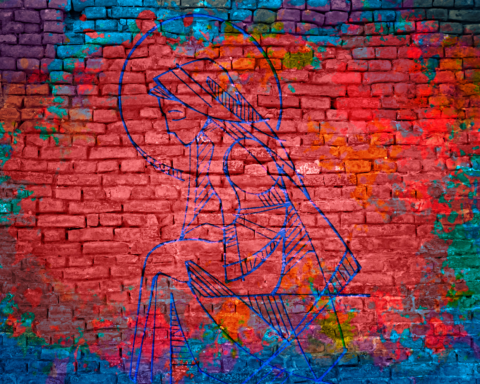
“In the time of King Herod, after Jesus was born in Bethlehem of Judea, wise men from the East came to Jerusalem, asking, ‘Where is the child who has been born king of the Jews? For we observed his star at its rising, and have come to pay him homage.’ … When they saw that the star had stopped, they were overwhelmed with joy. On entering the house, they saw the child with Mary his mother; and they knelt down and paid him homage. Then, opening their treasure chests, they offered him gifts of gold, frankincense, and myrrh.” – Matthew 2:1-2, 10-11
On his way out of the city every weekend, Iraj has his regular stops along the way to the Christian cemetery. He has developed a regular routine, which he follows religiously, giving him a sense of control and comfort. He wakes up early and has his tea that’s been brewing in the teapot on the electric samovar in the kitchen. Then he drives his little white Peugeot out of the parking space under the house and heads east out of the city, straight into the rays of the rising sun. It’s blissfully calm in Tehran on Friday mornings; on the Sabbath day, even the notorious traffic is at rest. Iraj makes good time and gets to his first stop out of the city by 8 o’clock.
___________________________________________
My Muslim stepfather had no issues with his wife being laid to rest as a Christian. So every week for the last 18 months since he lost her, he has been visiting her at the Christian Armenian cemetery.
___________________________________________
He takes the highway exit for the wholesale flower market, pulls up and parks near the first street vendors. Jumping out of the car like he’s on a mission (in a way he is), he doesn’t waste any time. The vendors all know him by now. He always buys two large bundles of flowers to take for Jeanny to the cemetery. (Jeanny – rhymes with honey – is what he called my Mom during their 40+ years together. It’s short for Jeannette and pronounced with a French J.) “Jeanny liked yellow flowers,” he tells me, “so I always take yellow flowers from myself.” Then he says, “But since you’re not here, I always take another big bunch to her from you.”

Photo: Noushin Framke
On this occasion, he buys a double bouquet of yellow roses, then goes to the next vendor and picks out a nice bouquet of purple Freesias, which my mom loved for their perfume. She loved sweet-scented flowers. When the Jasmine is in bloom in the garden, Iraj still picks a small bowlful of fragrant, white, star-shaped flowers off the vines every evening and brings them in for her, like he used to before she passed away. Now he sets the bowl of perfumed petals next to her framed picture, which is on the table in the TV room where he sits. He says he likes doing this for her and feels her presence still with him.
After the flower market, he gets back on the highway and heads further east until he takes the exit for the Armenian Cemetery. He pulls up to the big pale green metal double gates, which are wide open, with an attendant sitting in the shade. They know him there now, and he is waved in. He pulls up to his next stop inside the gates. There is a small kiosk where visitors can buy hot charcoal to take to gravesides. Iraj jumps out of the car, pulls out a small Riyal note, and pays the attendant, who hands over a lovely little beige clay flower pot full of glowing and white charcoal embers. The pot is warm to touch, but not too hot to hold. He takes it and puts it in the cup-holder in the front seat and drives further into the cemetery. Before long, he stops and gets out again. This time, the attendant hands him a little paper cone filled with what looks like a handful of tiny clear and yellow pebbles. They are, in fact, about an ounce of frankincense. The same kind the Persian Magi brought to Bethlehem for Jesus.
___________________________________________
Janet was born in 1930 in Iran to Armenian parents. Her mother was a refugee who escaped the Armenian genocide on foot, walking into northwestern Iran in 1915 as a ten-year-old, along with her siblings.
___________________________________________
Iraj winds the little white Peugeot through the narrow lanes of the Cemetery to Janet’s resting place. She went by “Janet” since the 1970s when she started writing the art column in the English language daily paper, The Tehran Journal. By the time of the Iranian Revolution in 1979, she was the art editor and had traveled the world over to cover various stories. She wrote on everything in the art scene, from opera and ballet to gallery events and theater, film festivals near and far, and everything in between. Janet Lazarianz is how everyone knew her.

Janet was born in 1930 in Iran to Armenian parents. Her mother was a refugee who escaped the Armenian genocide on foot, walking into northwestern Iran in 1915 as a ten-year-old, along with her siblings. They joined the Christian community in Iran, a community that has lived there for millennia, dating back to the earliest years of Christianity when the Persian tribes of Parthians, Medes, and Elamites joined the gathering at Pentecost. Being a member of the ancient Christian community, Janet was part of a protected and well-respected religious minority. (On the other hand, converts from Islam to Christianity are not protected, as Islam considers them apostate, but that’s another story).
On one of my trips to Iran before my mother died of cancer, she and I talked about where she was going to be buried. This can be a problem for the rare Christian woman, like my mother, who is married to a Muslim. In their traditional and patriarchal society, where a woman is buried is ultimately the decision of her husband, but my Muslim stepfather had no issues with his wife being laid to rest as a Christian. So every week for the last 18 months since he lost her, he has been visiting her at the Christian Armenian cemetery.
___________________________________________
One of the older Muslim ladies said to me, “It’s ok. Be comfortable. Be yourself. You can uncover your head here; it’s a Christian place.” To my surprise, I told her, “Thanks, but actually, as a Christian, here is where I feel I need to cover my head”.
___________________________________________
Christians and Muslims in Iran share a lot of the same traditions when it comes to mourning rites. Many of these apply also to the Jewish community, which is the largest in the Middle East, outside of Israel. Muslims and Jews do the burial immediately, within 24 hours; but Christians have a few days to hold the funeral. Beyond that difference, all three Abrahamic faith communities in Iran share the same timeline for mourning. They all have another ceremony on the 7th day, again on the 40th day, and finally on the one year anniversary.

My husband and I were glad to go to Iran over the summer to be there to mark the one-year anniversary of my mother’s passing. The day marks the official ending of the mourning period, and in traditional families – Christian, Muslim or Jewish – the women wear black for that whole year if the loved-one who has passed is a close relative. Sometimes, a woman who has been widowed will wear black the rest of her life; sometimes, on the death anniversary day, a family elder will bring a gift of an item of clothing that is not black, usually a scarf, as an indication that it is time to shed the mourning clothes.
I arrived in Tehran to mark the occasion my mother’s passing wearing all black out of respect for her and for my stepfather who was and still is devoted to her. On the day of the one-year ceremony, my stepfather invited everyone to come to the house, where a large air-conditioned bus took us out of town to the cemetery. I had already experienced the reeling emotions of arriving at my mother’s home without her there, of seeing all her things as if she was still in the next room. It was an emotional roller coaster, a whole year after she was gone.
___________________________________________
My Muslim stepfather has gone to a lot of trouble to make the resting place of his beloved Christian wife a beautiful spot.
___________________________________________
But on the ceremony day, I was sanguine. It was a hot day when we were in the cemetery, and not being used to covering my hair and wearing layers of all-black long clothing in the heat of summer, I became uncomfortably hot at the cemetery even by 10 am. One of the older Muslim ladies who is a good friend of the family said to me, “It’s ok. Be comfortable. Be yourself. You can uncover your head here; it’s a Christian place.” To my surprise, I told her, “Thanks, but actually, as a Christian, here is where I feel I need to cover my head”. Many Christian women in the Middle East cover their hair inside churches out of respect. I did so when I was in Bethlehem, Palestine, and went into the Church of the Nativity where the Armenian Church holds mass in the grotto where it is believed Christ was born in a manger. On that trip to Israel/Palestine, I carried around a long scarf so I could cover my head when I went into churches in Bethlehem, Nazareth, and Jerusalem. So I felt strangely at ease all covered up in mourning black. Even though it was hot, covering up felt right for a change.

Photo: Noushin Framke
On the weekly visits Iraj makes to the cemetery, he always makes his regular stops for flowers, a pot of glowing embers, and frankincense. He drives into the gates of the cemetery, past the little octagonal Armenian church, goes deep into the cross-covered leafy cemetery, an oasis in the parched yellow desert landscape outside the gates. My Muslim stepfather has gone to a lot of trouble to make the resting place of his beloved Christian wife a beautiful spot. He had the gravestone especially carved by a renowned sculptor in Armenia, then had the stone brought to Iran at great expense. The large stone is the familiar deep red color of Armenian stone; it has my mother’s name carved in three alphabets: Armenian, Latin, and Arabic. (Persian is an Indo-European language but uses the Arabic alphabet).
Iraj has also planted an olive tree at the gravesite, recalling her choice of gift on their marriage: an olive branch and a pair of white doves. In years to come, this tree will grow strong like my mother and deep like their love. In the meantime, he visits, every Friday, carefully placing every last piece of frankincense on the hot embers, fanning them patiently so they burn, sending up his prayers and words to her in the rising ribbons of smoke.
*****
AUTHOR BIO: Noushin Darya Framke is an Armenian/Iranian-American who has lived in the U.S. since 1978, when she arrived as a college student. Her freshman year turned out to be the year of the Iranian Revolution. She is a Presbyterian elder, writer, and editor who has been involved in advocacy and education with the denomination’s Israel/Palestine Mission Network, theIPMN.org. Also read Noushin’s 2010 article about being an Iranian Christian form Horizons, the magazine of Presbyterian Women.





Unbound Social